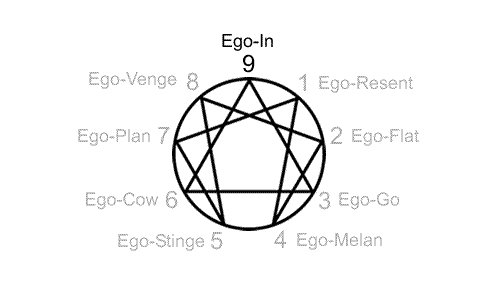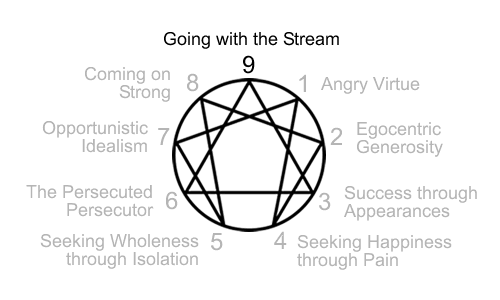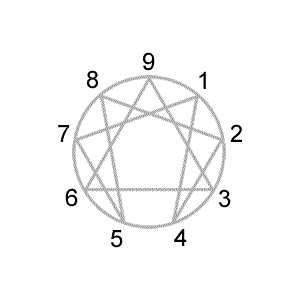Enneagram Type 9: Harmony through Behavioral Accommodation
The core focus of Enneagram type 9

We all have to live together, so we might as well live together happily.
- 14th Dalai Lama
Early in life we develop an initial belief about ourselves and a compensation for that self-belief.
-
Type 9 Initial Self-Belief: “I am not in unity as I am.”
Type 9 Compensation: "I must accommodate others' agenda and opinions in order to feel at ease and in harmony with them."
Over time this gets generalized beyond the self into a core focus that also shapes how we perceive and interact with the world at large.
-
Type 9 Core Focus: Harmony comes from getting along with others and falling into comfortable routines. This requires that I accommodate others by finding common ground and minimizing my own agenda when around others as well as finding comfort and peace of mind for myself.
Personality characteristics that might arise from the type 9 core focus include:
- Loses sight of own agenda in favor of the agenda of others
- Smooths over conflict in order to keep the peace and feel more at ease
- Has difficulty establishing goals and following through on them
- Struggles with inertia: getting going or changing course once underway
- Gets lost in peripheral activities that don't serve the primary objective
- Avoids creating separation from people by going along to get along
- Supresses anger which may surface as stubbornness or passive-aggressiveness
- Finds it difficult to prioritize because everything can seem equally important
- Numbs themself through comfort seeking and getting lost in routine
Enneagram author descriptions of type 9

Below are Enneagram type 9 description samplings from some popular or well-known Enneagram authors. Click on the sources after the descriptions to further explore these interpretations.
-
The Peacemaker, The Easygoing, Self-Effacing Type: Receptive, Reassuring, Agreeable, and Complacent1
Basic Fear: Of loss and separation, of annihilation1
Basic Desire: To maintain their inner stability and peace of mind1
-
How Nines Pay Attention: When Nines “go on automatic,” they can complete complicated tasks without paying conscious attention to what their hands and bodies are doing.2
Basic Proposition: You gain belonging by merging with others, and comfort by dispersing your energy into objects and activities.2
Strengths: Excellent mediators, caring, supportive, adaptive, steady, receptive, non-judgmental2
Challenges: Stubborn, ambivalent, self-forgetful, indecisive, conflict-avoidant2
-
Energy goes into: Being sensitive to others and trying to please them instead of myself. Keeping life comfortable and familiar. Maintaining harmony, structure, and routine to make life predictable. Containing anger. Doing the less essential and comforting activities rather than the more important and more disturbing ones.3
-
The Peacemaker: Pleasant, laid back and accommodating, they are motivated by a need to keep the peace, merge with others and avoid conflict.4
-
Peacemakers are receptive, good-natured, and supportive. They seek union with others and the world around them.5
-
Focus of Attention: Nines focus attention on others, on what is going on in the environment, and on avoiding conflict and achieving harmony. Nines typically tune into what other people want, but do not have a clear sense of their own agendas.6
Sources
1Book: The Wisdom of the Enneagram; Website: The Enneagram Institute
2Book: The Enneagram; Website: The Narrative Enneagram
3Book: The Essential Enneagram; Website: Dr. David Daniels
4Book: The Road Back to You
5Book: The Enneagram Made Easy
6Book: The Complete Enneagram; Website: Chestnut Paes Enneagram Academy
Type 9 Ego: Ego-In

The roots of the Enneagram types come from Oscar Ichazo's ego types. The ego types identified how a person was fixated in ego and the remedy for finding freedom from that.
Below are descriptions of Oscar Ichazo's ego type 9 fixation, trap, holy idea, passion, and virtue reinterpreted for today's Enneagram personality types.
Type 9 Fixation and Trap
Fixation: Indolence is about resisting demands and expectations that disrupt a feeling of harmony and continuity.
Trap: A seeker of harmony and belonging that accommodates by going along with others and not rocking the boat.
The fixation of indolence points to the mental preoccupation of the type 9 ego. The trap of seeker keeps an individual stuck in the fixation.
Type 9 Holy Idea
Holy Idea: Holy Love is realizing that love comes to you not by negating yourself for the sake of others but by discovering and pursuing your own path.
The fixation of indolence and trap of seeker keep an individual stuck in the type 9 fixation. The way out of that fixation is through holy love.
Type 9 Passion
Passion: Laziness is a difficulty with defining and accomplishing goals. "I tend to go along with what others are doing and lose myself in routine and comfort."
The passion of laziness is the emotional energy that serves the fixation of indolence and trap of seeker.
Type 9 Virtue
Virtue: Action appears when you pursue what's meaningful to you instead of simply going along to get along or falling into habitual routines and comfort.
The virtue of action is what appears when the passion of laziness subsides.
Personality traits of Enneagram type 9

A psychiatrist named Claudio Naranjo evolved Oscar Ichazo's ego-types into the Enneagram personality types as we use them today. Naranjo largely based the types on Ichazo's passions.
Naranjo outlined the following trait structure for type 9 (Ennea-type IX) in his books Ennea-type Structures and Character and Neurosis.
- Going with the Stream - Accidia, the Passion for Comfort and the Overadjusted Disposition
- Psychological Inertia
- Over-Adaptation
- Resignation
- Generosity
- Ordinariness
- Robotic Habit-Boundedness
- Distractibility
Enneagram type 9 examples
While reading about the Enneagram types can be useful in understanding them, you eventually have to bring the types to life by seeing the many different ways they get expressed in life.
While the ideal is to be able to interact directly with people of each type, an alternative is to observe them from a distance. There are a number of ways to do this using videos. Many of these videos can be found on the Internet if you know what to look for (YouTube in particular).
- Type 9 Interviews and Self-Revelations
One method used to bring the types to life when teaching the Enneagram types involves interviewing people of a given type about how that type plays out in their life. This may be done through panels and one-on-one interviews.
Self-revelatory videos can also be useful where a person simply describes their type to a camera without the prompting of an interviewer.
Note that sometimes a person in a video may have been mistyped and may not offer an accurate representation of type when that happens.
- Type 9 Celebrities or Famous People
Once their Enneagram type is known, celebrities or famous people can also offer interesting examples of and insights into Enneagram type as revealed through interviews, lectures, writings, and the person's work.
However, it's not like the Enneagram panels, interviews, and self-revelations where people are specifically describing how they experience Enneagram type in their lives. It's more a matter of looking for glimpses into how Enneagram type is operating in the person.
It can be difficult to type someone at a distance. Look for a consensus of opinion on a person's type from multiple sources and hold it loosely. Celebrities and famous people are often typed differently by different Enneagram authors, teachers, and enthusiasts.
- Type 9 Fictional Characters
It needs to be made clear that fictional characters are not real people, even when they are based on real people. There can be a temptation to assign Enneagram type to every character in a story, but many characters don't have that kind of consistency or depth.
Not only might there be a number of different people, usually of different types, influencing the creation or portrayal of a character but often the character is nothing more than a vehicle for telling the story and moving it along.
While once in a while a character appears that you can attribute an Enneagram type to, generally it's more accurate to look at specific scenes as examples of a type rather than the character as a whole.
Tom Condon wrote a book called The Enneagram Movie & Video Guide that you may find useful for seeing type in fictional characters.
- Type 9 Songs and Lyrics
Although they do exist, there are few song lyrics that can be attributed to one particular Enneagram type. Most songs have both lyrical and musical elements that can be attributed to a number of different Enneagram types.
Songs are extremely subjective. There are many songs that listeners, and even performers, interpret in a very different way than the song writer intended. A number of songs also emphasize the sounds of words rather than their meaning.
As such, different people hearing the same song often will experience it as representing different Enneagram types.
Enneagram type 9 variations
There are a number of variations or flavors of type 9 that help explain why two people of the same type seem different. Click below for more info about variations of type 9.
Type 9 mistypes
Some people correctly identify their Enneagram type on their first try. For most other people determining type can take some time.
If you feel that you may have wrongly typed yourself as type 9 and have one or more alternative candidate types in mind then click on a link below to take a quick Enneagram test comparing type 9 to another type that may instead be your type.
Enneagram Tests to Help Determine Type

The Enneagram personality types consist of nine basic types. One of the types will be more dominant than the others. This dominant type is said to be "your Enneagram type".
Although there are nine basic Enneagram types, there are also many variations within each type as defined by such concepts as wings, centers, and instincts.
You can explore these variations using the type preference test below or one of the many other tests available on this website.
-
Enneagram Type Preference Test
This test produces a scored list of all nine types.
Questions are forced-choice, similar to the method used by the Riso-Hudson Enneagram Type Indictor (RHETI).
Use to determine type, wings, gut/heart/head types, and tri-center. -
Enneagram Type Comparison Test
This test compares any two types. The preferred type will have the higher score.
Use when you've narrowed your type down to two or three possibilities you'd like to compare.
Click here for the Complete Guide to the Enneagram.
This free guide explains- the nine Enneagram personality types
- the many type variations within type
- where the types came from (origins and history)
- how the types use the Enneagram symbol
Click here for Enneagram tests.
These free tests help you find your- primary type
- candidate types
- preferred wing
- intinctual subtype
- instinctual variant stacking
- center types (gut, heart, and head)
- tri-center with wings